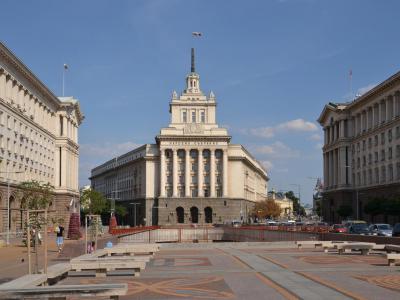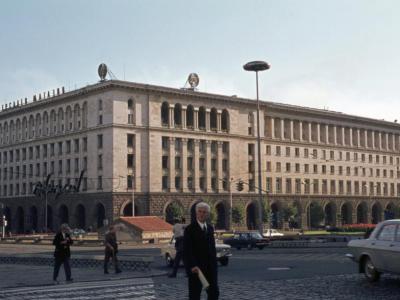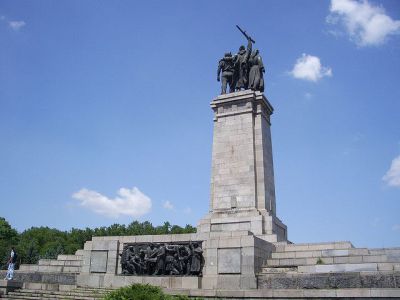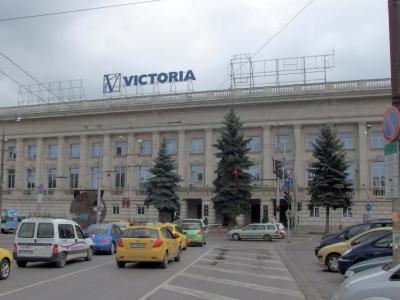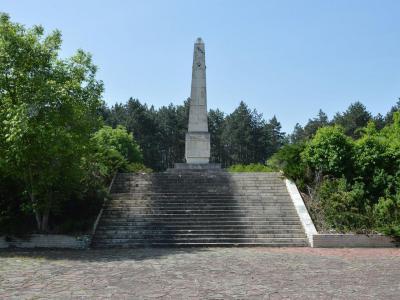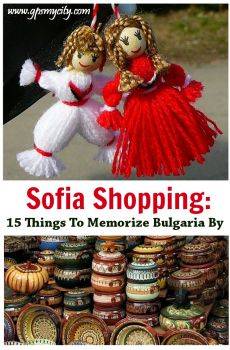Communist Era Landmarks Walk (Self Guided), Sofia
In the not-so-distant past Bulgaria was part of the Soviet-led Eastern Bloc. Today, this is one of the few countries where you can still find numerous relics of the Communist era manifested in monumental architectural landmarks. Concrete and metal were the main materials as a symbol of the industrialized nation, and the size was important too as a common architectural characteristic prescribed by a massive cultural policy of the Communist state.
The best place to start exploring Communist Landmarks in Sofia is the former headquarters of the Communist Party of Bulgaria. Part of the so-called Largo complex, it dominates the city center and is considered one of the finest examples of postwar Communist architecture in Southeastern Europe.
Apart from the Party House, the Largo comprises two more Stalinist Empire-style buildings constructed in the 1950s: the TZUM-Central Department Store and the President’s Office.
Integral of the cultural Communist heritage are the monuments of colossal dimensions. One such is the Monument to the Soviet Army, erected to pay homage to the soldiers who liberated Bulgaria from fascism. Also legendary and equally impressive is the Mound of Brotherhood, a 42-meter obelisk commemorating the partisans who fell during World War II.
Typically monumental art from the late 20th century resulted in landmarks that illustrate historic events, using specific historic images. If you are a fan of brutalist art, you may wish to check out the Museum of Socialist Art. Here the outdoor area is dotted with all the unwanted stern-looking statues from the said period, while the nearby indoor gallery houses some stirring artwork.
If you want to delve deeper into the Communist-era Sofia for a bit of feeling of what it was like on the east side of the Iron Curtain, take this self-guided historic walking journey and discover some of the key symbols of the Soviet legacy in the city.
The best place to start exploring Communist Landmarks in Sofia is the former headquarters of the Communist Party of Bulgaria. Part of the so-called Largo complex, it dominates the city center and is considered one of the finest examples of postwar Communist architecture in Southeastern Europe.
Apart from the Party House, the Largo comprises two more Stalinist Empire-style buildings constructed in the 1950s: the TZUM-Central Department Store and the President’s Office.
Integral of the cultural Communist heritage are the monuments of colossal dimensions. One such is the Monument to the Soviet Army, erected to pay homage to the soldiers who liberated Bulgaria from fascism. Also legendary and equally impressive is the Mound of Brotherhood, a 42-meter obelisk commemorating the partisans who fell during World War II.
Typically monumental art from the late 20th century resulted in landmarks that illustrate historic events, using specific historic images. If you are a fan of brutalist art, you may wish to check out the Museum of Socialist Art. Here the outdoor area is dotted with all the unwanted stern-looking statues from the said period, while the nearby indoor gallery houses some stirring artwork.
If you want to delve deeper into the Communist-era Sofia for a bit of feeling of what it was like on the east side of the Iron Curtain, take this self-guided historic walking journey and discover some of the key symbols of the Soviet legacy in the city.
How it works: Download the app "GPSmyCity: Walks in 1K+ Cities" from Apple App Store or Google Play Store to your mobile phone or tablet. The app turns your mobile device into a personal tour guide and its built-in GPS navigation functions guide you from one tour stop to next. The app works offline, so no data plan is needed when traveling abroad.
Communist Era Landmarks Walk Map
Guide Name: Communist Era Landmarks Walk
Guide Location: Bulgaria » Sofia (See other walking tours in Sofia)
Guide Type: Self-guided Walking Tour (Sightseeing)
# of Attractions: 6
Tour Duration: 3 Hour(s)
Travel Distance: 6.6 Km or 4.1 Miles
Author: DanaOffice
Sight(s) Featured in This Guide:
Guide Location: Bulgaria » Sofia (See other walking tours in Sofia)
Guide Type: Self-guided Walking Tour (Sightseeing)
# of Attractions: 6
Tour Duration: 3 Hour(s)
Travel Distance: 6.6 Km or 4.1 Miles
Author: DanaOffice
Sight(s) Featured in This Guide:
- Former Communist Party House (The Largo)
- TZUM (Central Department Store)
- Monument to the Soviet Army
- Vasil Levski National Stadium
- Mound of Brotherhood
- Museum of Socialist Art
1) Former Communist Party House (The Largo)
The Largo is the Former Communist Party House in Sofia, Bulgaria. The structure was built in 1955. It was designed by architect Petso Zlatev in the Socialist Classicism architectural style. It is known as one of the most significant landmarks in Sofia.
The Largo sits on Independence Square. The square consists of yellow cobblestone between the Knyaz Aleksandar Dondukov Boulevard and Tsar Osvoboditel Boulevard. The square includes a fountain, which was added in 1958, and a statue of Saint Sophia, added in 2000. There were previously a number of communist symbols, including a statue of Vladimir Lenin and a red star atop a pole, that were removed in 1989.
The Former Communist Party House is now used as the seat of the National Assembly. The edifices on each side are occupied by the TZUM department store, the Council of Ministers of Bulgaria, the Ministry of Education, the Sofia Hotel Balkan and the President's Office.
The Largo sits on Independence Square. The square consists of yellow cobblestone between the Knyaz Aleksandar Dondukov Boulevard and Tsar Osvoboditel Boulevard. The square includes a fountain, which was added in 1958, and a statue of Saint Sophia, added in 2000. There were previously a number of communist symbols, including a statue of Vladimir Lenin and a red star atop a pole, that were removed in 1989.
The Former Communist Party House is now used as the seat of the National Assembly. The edifices on each side are occupied by the TZUM department store, the Council of Ministers of Bulgaria, the Ministry of Education, the Sofia Hotel Balkan and the President's Office.
2) TZUM (Central Department Store)
TZUM, The Central Department Store, is a department store that opened in Sofia in 1957. It occupies a monumental edifice that is part of the Former Communist Party House (The Largo) complex. Though the bulk of The Largo was designed by architect Petso Zlatev, the TZUM building was designed by Kosta Nikolov and was completed in 1956, one year after the completion of the remainder of The Largo. During the communist time, TZUM is the place to go for high-end shopping in Sofia.
The department store was built with seven floors and an inner courtyard. It underwent massive reconstruction in 1986 with a new design by architect Atanas Nikolov. Soon after, TZUM was sold to a private party so that it could be used as boutiques rather than a public department store as it was when Bulgaria was under communist rule.
TZUM now has office space and restaurants but it remains mostly occupied by numerous boutiques. These shops sell luxury gifts, jewelry, shoes, clothing, cosmetics and electronics.
The department store was built with seven floors and an inner courtyard. It underwent massive reconstruction in 1986 with a new design by architect Atanas Nikolov. Soon after, TZUM was sold to a private party so that it could be used as boutiques rather than a public department store as it was when Bulgaria was under communist rule.
TZUM now has office space and restaurants but it remains mostly occupied by numerous boutiques. These shops sell luxury gifts, jewelry, shoes, clothing, cosmetics and electronics.
3) Monument to the Soviet Army
The Monument to the Soviet Army is a statue near the center of Sofia. It shows a solder from the Soviet Army with a Bulgarian man and a Bulgarian woman who is holding a baby. Surrounding the monument are sculptures showing groups of soldiers who are said to be freedom fighters.
The monument is located in the midst of Cherni Vrah Garden, a large park surrounded by Cherni Vrah Boulevard. It was built in 1954 on the 10th anniversary of the liberation by the Soviet Army.
The monument has been a subject of much controversy in Sofia. In 2011, a group of anonymous artists called Destructive Creation painted the soldiers to look like American pop culture figures. Some of these included Ronald McDonald, Captain America and Superman. The paint was removed just a few days later.
In 2012, the monument was given Guy Fawkes masks. In 2013, three of the figures were painted to match the Bulgarian national flag. These types of activities have occurred many times throughout the years. Most recently, the monument was painted the colors of the Ukrainian flag in reaction to the Russian invasion of Ukraine.
The monument is located in the midst of Cherni Vrah Garden, a large park surrounded by Cherni Vrah Boulevard. It was built in 1954 on the 10th anniversary of the liberation by the Soviet Army.
The monument has been a subject of much controversy in Sofia. In 2011, a group of anonymous artists called Destructive Creation painted the soldiers to look like American pop culture figures. Some of these included Ronald McDonald, Captain America and Superman. The paint was removed just a few days later.
In 2012, the monument was given Guy Fawkes masks. In 2013, three of the figures were painted to match the Bulgarian national flag. These types of activities have occurred many times throughout the years. Most recently, the monument was painted the colors of the Ukrainian flag in reaction to the Russian invasion of Ukraine.
4) Vasil Levski National Stadium
Vasil Levski National Stadium is a stadium that is used for athletic competitions, derbies, concerts and music festivals. It is the home venue for Levski Sofia's league games. This is the country's second largest stadium with more than 43,000 seats.
The stadium was named after Vasil Levski, a revolutionary and Bulgarian national hero. It was opened in 1953 with just a lower tier. The second tier wasn't added until the 1960s. This stadium replaced Levski Field, built in 1934, which in turn replaced the Yunak Stadium that was constructed in 1928.
The stadium offers a number of options along with the football field. It is equipped for judo, gymnastics, basketball, boxing, fencing and table tennis. It also has three restaurants on site. During the communist time, the stadium is the largest and the most important sport stadium in the country. Many, if not most, of the important national and international sport events during that era took place here.
Vasil Levski National Stadium is well known as a concert venue. The largest concert ever held in Bulgaria took place at this stadium. It was held by Lepa Brena who performed for more than 100,000 fans. Other artists who have appeared at Vasil Levski National Stadium include Bon Jovi, Guns n Roses, Metallica and Madonna.
The stadium was named after Vasil Levski, a revolutionary and Bulgarian national hero. It was opened in 1953 with just a lower tier. The second tier wasn't added until the 1960s. This stadium replaced Levski Field, built in 1934, which in turn replaced the Yunak Stadium that was constructed in 1928.
The stadium offers a number of options along with the football field. It is equipped for judo, gymnastics, basketball, boxing, fencing and table tennis. It also has three restaurants on site. During the communist time, the stadium is the largest and the most important sport stadium in the country. Many, if not most, of the important national and international sport events during that era took place here.
Vasil Levski National Stadium is well known as a concert venue. The largest concert ever held in Bulgaria took place at this stadium. It was held by Lepa Brena who performed for more than 100,000 fans. Other artists who have appeared at Vasil Levski National Stadium include Bon Jovi, Guns n Roses, Metallica and Madonna.
5) Mound of Brotherhood
The Mound of Brotherhood is a monument to the partisan fighters who were killed during World War II. It was constructed from a design by numerous architects and artists. The monument is sometimes referred to as the Fraternal Mound.
The monument is located in Borisova Garden, which was previously known as Freedom Park. It was built next to the remains of 17 resistance fighters and members of the Bulgarian Communist Party.
The monument is an obelisk with two bronze sculptures of partisan fighters holding their weapons. Reliefs show the Bulgarian people, a welcome to the Soviet Army and a celebration on September 9, 1944.
It is argued that the monument is the most famous socialist monument in the city. The monument was opened in 1956 on the 80th anniversary of the death of Bulgarian revolutionary Hristo Botev. An inscription on the monument shares a quote from Botev: He who dies in a fight for freedom never dies.
The monument is located in Borisova Garden, which was previously known as Freedom Park. It was built next to the remains of 17 resistance fighters and members of the Bulgarian Communist Party.
The monument is an obelisk with two bronze sculptures of partisan fighters holding their weapons. Reliefs show the Bulgarian people, a welcome to the Soviet Army and a celebration on September 9, 1944.
It is argued that the monument is the most famous socialist monument in the city. The monument was opened in 1956 on the 80th anniversary of the death of Bulgarian revolutionary Hristo Botev. An inscription on the monument shares a quote from Botev: He who dies in a fight for freedom never dies.
6) Museum of Socialist Art
The Museum of Socialist Art is an art museum that spans the communist era in Bulgaria. Its collections include statues, busts and paintings that were created from 1944 to 1989. Along with the exhibition hall, the museum features a media hall and a sculpture park.
The museum was established in 2011. It was founded alongside the Museum of Contemporary Art, the Museum of Ancient Sofia and the National Museum Complex. The Museum of Socialist Art's role was to showcase art that was created during the communist era and to restore those monuments that were dismantled. The exhibits came from public spaces as well as private individuals who donated their own found and crafted items that had been hidden since the fall of communism in the country.
Visitors to the museum can find a souvenir kiosk where they can purchase communist-era memorabilia, t-shirt and postcards. The museum is open from Tuesday through Sunday from 10 AM to 6 PM.
The museum was established in 2011. It was founded alongside the Museum of Contemporary Art, the Museum of Ancient Sofia and the National Museum Complex. The Museum of Socialist Art's role was to showcase art that was created during the communist era and to restore those monuments that were dismantled. The exhibits came from public spaces as well as private individuals who donated their own found and crafted items that had been hidden since the fall of communism in the country.
Visitors to the museum can find a souvenir kiosk where they can purchase communist-era memorabilia, t-shirt and postcards. The museum is open from Tuesday through Sunday from 10 AM to 6 PM.
Walking Tours in Sofia, Bulgaria
Create Your Own Walk in Sofia
Creating your own self-guided walk in Sofia is easy and fun. Choose the city attractions that you want to see and a walk route map will be created just for you. You can even set your hotel as the start point of the walk.
Sofia Introduction Walking Tour
Sofia, the capital of Bulgaria, is one of Europe’s oldest continuously inhabited cities, with archaeological traces of settlement dating back at least 7,000 years. Its fertile valley, abundant mineral springs, and position on major east–west and north–south routes made it a natural crossroads for ancient peoples.
The Thracian tribe Serdi established a settlement here in the 1st... view more
Tour Duration: 2 Hour(s)
Travel Distance: 2.6 Km or 1.6 Miles
The Thracian tribe Serdi established a settlement here in the 1st... view more
Tour Duration: 2 Hour(s)
Travel Distance: 2.6 Km or 1.6 Miles
Useful Travel Guides for Planning Your Trip
Sofia Shopping: 15 Things To Memorize Bulgaria By
Increasingly popular tourist destination in recent years, Bulgaria has opened up to the outer world, revealing colorful identity, manifested in rich craftsmanship, culinary and cultural traditions and history. The country's capital city Sofia is a lovely alloy of Eastern and Western European...
The Most Popular Cities
/ view all



